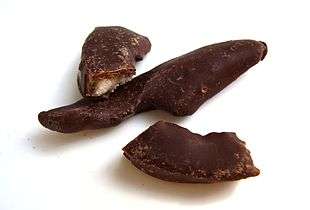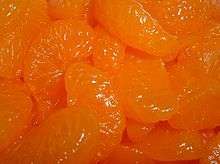Mandarin orange
| Mandarin orange | |
|---|---|
| | |
| Scientific classification | |
| Kingdom: | Plantae |
| (unranked): | Angiosperms |
| (unranked): | Eudicots |
| (unranked): | Rosids |
| Order: | Sapindales |
| Family: | Rutaceae |
| Genus: | Citrus |
| Species: | C. reticulata |
| Binomial name | |
| Citrus reticulata Blanco | |
The mandarin orange (Citrus reticulata; Chinese: 橘子, p júzi; Cantonese: 柑, kam¹ or gam¹), also known as the mandarine, is a small citrus tree with fruit resembling other oranges.
Mandarins are usually eaten plain or in fruit salads. Specifically reddish-orange mandarin cultivars can be marketed as tangerines, but this is not a botanical classification.
Mandarins are smaller and oblate, rather than spherical like the common oranges (which are a mandarin hybrid). The taste is considered less sour, as well as sweeter and stronger.[1] A ripe mandarin is firm to slightly soft, heavy for its size, and pebbly-skinned. The peel is very thin, with very little bitter white mesocarp,[2] so they are usually easier to peel and to split into segments. Hybrids generally have these traits to a lesser degree.
The tree is more drought-tolerant than the fruit. The mandarin is tender and is damaged easily by cold. It can be grown in tropical and subtropical areas.
According to molecular studies,[3] the mandarin, the citron, the pomelo, and the papeda were the ancestors of most other commercial citrus varieties, through breeding or natural hybridization; mandarins are therefore all the more important as the only sweet fruit among the parental species.
Etymology
The name "mandarin orange" is a calque of Swedish mandarin apelsin, first attested in the 18th century. The form "mandarine" derives from the French name for this fruit. The reason for the epithet "mandarin" is not clear, hypotheses ranging from the yellow colour of some robes worn by mandarin dignitaries to the mandarin being an excellent kind of Chinese orange.[4]
Uses
Fresh mandarins
Mandarins are generally peeled and eaten fresh. The fresh fruit is also used in salads, desserts and main dishes. Fresh tangerine juice and frozen juice concentrate are commonly available in the United States. The number of seeds in each segment (carpel) varies greatly.
Peel
The peel is used fresh, whole or zested, or dried as chenpi. It can be used as a spice for cooking, baking, drinks, or candy.
Canning
Canned mandarin segments are peeled to remove the white pith prior to canning; otherwise, they turn bitter. Segments are peeled using a chemical process. First, the segments are scalded in hot water to loosen the skin; then they are bathed in a lye solution, which digests the albedo and membranes. Finally, the segments undergo several rinses in plain water. They are often used in salads, desserts, and baking.
Traditional medicine
In traditional Chinese medicine, the dried peel of the fruit is used in the regulation of ch'i, and also used to treat abdominal distension, to enhance digestion, and to reduce phlegm.[5] Mandarins have also been used in ayurveda (traditional medicine of India).[6]
Production volume and nutrition
| Nutritional value per 100 g (3.5 oz) | |
|---|---|
| Energy | 223 kJ (53 kcal) |
|
13.34 g | |
| Sugars | 10.58 g |
| Dietary fiber | 1.8 g |
|
0.31 g | |
|
0.81 g | |
| Vitamins | |
| Vitamin A equiv. |
(4%) 34 μg (1%) 155 μg |
| Thiamine (B1) |
(5%) 0.058 mg |
| Riboflavin (B2) |
(3%) 0.036 mg |
| Niacin (B3) |
(3%) 0.376 mg |
| Pantothenic acid (B5) |
(4%) 0.216 mg |
| Vitamin B6 |
(6%) 0.078 mg |
| Folate (B9) |
(4%) 16 μg |
| Choline |
(2%) 10.2 mg |
| Vitamin C |
(32%) 26.7 mg |
| Vitamin E |
(1%) 0.2 mg |
| Minerals | |
| Calcium |
(4%) 37 mg |
| Iron |
(1%) 0.15 mg |
| Magnesium |
(3%) 12 mg |
| Manganese |
(2%) 0.039 mg |
| Phosphorus |
(3%) 20 mg |
| Potassium |
(4%) 166 mg |
| Sodium |
(0%) 2 mg |
| Zinc |
(1%) 0.07 mg |
|
| |
| |
|
Percentages are roughly approximated using US recommendations for adults. Source: USDA Nutrient Database | |
| Tangerines, mandarins, clementines, satsumas Top 20 producers in 2011 (1000 tonnes) | |
|---|---|
| | 12,482 |
| | 2,117 |
| | 1,005 |
| | 928 |
| | 872 |
| | 853 |
| | 848 |
| | 800 |
| | 753 |
| | 681 |
| | 596 |
| | 515 |
| | 406 |
| | 401 |
| | 360 |
| | 236 |
| | 218 |
| | 197 |
| | 179 |
| | 152 |
| All other | 1,582 |
| World total | 26,030 |
| Source: UN Food and Agriculture Organisation (FAO),[7] | |
Cultural significance
During Chinese New Year, mandarin oranges/tangerine/satsumas are considered traditional symbols of abundance and good fortune. During the two-week celebration, they are frequently displayed as decoration and presented as gifts to friends, relatives, and business associates.
Mandarin oranges, particularly from Japan, are a Christmas tradition in Canada, the United States and Russia. In the United States, they are commonly purchased in 5- or 10-pound boxes, individually wrapped in soft green paper, and given in Christmas stockings. This custom goes back to the 1880s, when Japanese immigrants in the United States began receiving Japanese mandarin oranges from their families back home as gifts for the New Year. The tradition quickly spread among the non-Japanese population, and eastwards across the country: each November harvest, "The oranges were quickly unloaded and then shipped east by rail. 'Orange Trains' – trains with boxcars painted orange – alerted everyone along the way that the irresistible oranges from Japan were back again for the holidays. For many, the arrival of Japanese mandarin oranges signaled the real beginning of the holiday season."[8]

This Japanese tradition merged with European traditions related to the Christmas stocking. Saint Nicholas is said to have put gold coins into the stockings of three poor girls so that they would be able to afford to get married.[9] Sometimes the story is told with gold balls instead of bags of gold, and oranges became a symbolic stand-in for these gold balls, and are put in Christmas stockings in Canada[9][10] along with chocolate coins wrapped in gold foil.
Satsumas were also grown in the United States from the early 1900s, but Japan remained a major supplier.[11] U.S. imports of these Japanese oranges was suspended due to hostilities with Japan during World War II.[8] While they were one of the first Japanese goods allowed for export after the end of the war, residual hostility led to the rebranding of these oranges as "mandarin" oranges.[8]
The delivery of the first batch of mandarin oranges from Japan in the port of Vancouver, British Columbia (Canada), is greeted with a festival that combines Santa Claus and Japanese dancers[10]—young girls dressed in traditional kimonos.[12]
In Russia, mandarin oranges are traditionally used as Christmas tree and New Year tree decorations. In Russia, mandarin oranges (tangerines) have traditionally been supplied from Morocco and are associated with that country, even though nowadays they are also supplied from other countries, e.g. Spain, Israel and Egypt.
Historically, the Christmas fruit imported to North America was mostly Dancys, but now it is more often a hybrid.[13]
Genetics
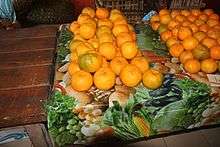
Mandarins are one of the four core ancestral citrus taxa, and are thought to have evolved in Vietnam, south China, and Japan.[14]
Pure mandarins seem to divide into two groups; an edible group, including the Nanfengmiju, and an "acidic" group, which is too sour to be edible but which is widely used as rootstock and grown for juice; this includes Sunki, Shekwasha, and Cleopatra mandarins.[15]
Under the Tanaka classification system, mikans, satsumas, tangerines etc. are considered to be divided into different species, including Citrus unshiu and Citrus tangerina. Under the Swingle system, all these are considered to be groups of mandarin varieties.[15] Unshius and tangerines genetically resemble mandarins,[15] but the genetics are still not thoroughly studied.
Like all citrus fruit, mandarins hybridize readily with other citrus. Many fruit sold as mandarins are in fact hybrids with some pummelo (C. maxima) ancestry, and are thus on a continumn with clementines, sweet and sour oranges, and grapefruit.[14]
Hybrids between mandarins and other citrus fruits are sold under a variety of names; see below.
Varieties
Mandarins marketed as tangerines in the US are or were usually Dancy, Sunburst or Murcott (Honey) cultivars; Sunbursts and Murcotts are hybrids.
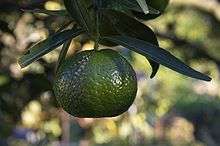
Pure mandarins
- Nanfengmiju (Citrus reticulata Blanco)[16] A rare non-hybrid citrus.[14] One of the most widely cultivated varieties in China.[17]
- Cleopatra mandarin[14]
- Shekwasha, a very sour mandarin grown for its acidic juice.
- Sunki[14]
- Sun Chu Sha[14]
- ? The Dancy may be a pure mandarin.[18] Until the 1970s, most tangerines grown and eaten in the USA were Dancys, and it was known as "Christmas tangerine"[13] and zipper-skin tangerine[19]
- ? Obenimikan may be a synonym for Dancy[20]
- Bang Mot tangerine is a popular variety in Thailand
Unknown
- "Mandarin"; some fruit sold as mandarins in some jurisdictions is in fact hybrid.
- Satsuma (Citrus unshiu), may be a type of pure mandarin, but the term is sometimes applied to hybrids. It is a seedless variety, of which there are over 200 cultivars, including Wenzhou migana, Owari, and mikan; the source of most canned mandarins, and popular as a fresh fruit due to its ease of consumption
- Owari, a well-known Satsuma cultivar that ripens during the late autumn
- Kishumikan
- Komikan
- Tangerines (Citrus tangerina)[21] may be a type of pure mandarin. However, some tangerine-grapefruit hybrids are legally sold as tangerines in the USA.[22][23]
Hybrids with mandarin ancestry
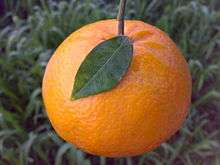
- Lemandarins
- Meyer lemon, a mandarin–lemon hybrid.
- Rangpur, a different mandarin–lemon hybrid.
- Mandarin–pumelo hybrids, sometimes called mandelos
- The Mandelo cultivar, a specific indirect complex mandarin–pumelo hybrid
- Huanglingmiao, a mandarin–pumelo hybrid[18][24]
- The Ponkan, a mandarin–pumelo hybrid[14][25]
- Mediterranean/Willowleaf/Thorny (Citrus × deliciosa), a mandarin–pumelo hybrid[25]
- Kinnow (see image), a 'King' (Citrus nobilis) × 'Willow Leaf' (Citrus × deliciosa) hybrid.
- The common sweet orange is 75% mandarin and 25% pumelo
- Tangors, or temple oranges, are crosses between the mandarin orange and the common sweet orange;[24] their thick rind is easy to peel and its bright orange pulp is sour-sweet and full-flavored
- Clementine, (Citrus ×clementina), a hybrid between a mandarin orange and a sweet orange,[25] so named in 1902;[26] sometimes known as a "Thanksgiving Orange" or "Christmas orange", as its peak season is winter; an important commercial mandarin orange form, having displaced mikans in many markets
- Clemenules or Nules, a variety of Clementine named for the Valencian town where it was first bred in 1953; it is the most popular variety of Clementine grown in Spain.[27]
- Murcott, a mandarin–sweet orange hybrid.[25][28]
- Tango is a proprietary seedless mid-late season irradiated selection of murcott developed by the University of California Citrus Breeding Program.[29]
- Fairchild is a Clementine-Orlando) hybrid
Non-mandarins
- Mangshanyegans, long thought to be mandarins, are in fact a separate species.[24]
Biological characteristics
Citrus fruits are usually self-fertile (needing only a bee to move pollen within the same flower) or parthenocarpic (not needing pollination and therefore seedless, such as the satsuma).
Blossoms from the Dancy cultivar are one exception. They are self-sterile, and therefore must have a pollinator variety to supply pollen, and a high bee population to make a good crop.
See also
- Japanese citrus
- List of citrus fruits
- Tangerine
- Citrus unshiu
- Ju Song – "In Praise of the Orange-Tree"
References
- ↑ Pittman & Davis (1999-02-22). "Pittman & Davis – Premium Citrus Fruit Gifts – Why Are Tangerines So Tangy?". Pittmandavis.com. Retrieved 2012-11-17.
- ↑ "Market Watch: The wild and elusive Dancy". David Karp, LA Times. http://www.latimes.com/food/la-fo-marketwatch-20110128-story.html
- ↑ "International Citrus Genomics Consortium". University of California.
- ↑ "Chinese loanwords in the OED". The Free Library. Retrieved October 5, 2016.
- ↑ Yeung. Him-Che. Handbook of Chinese Herbs and Formulas. 1985. Los Angeles: Institute of Chinese Medicine.
- ↑ Chopra, R. N.; Nayar, S. L.; Chopra, I. C. Glossary of Indian Medicinal Plants. 1986. New Delhi: Council of Scientific and Industrial Research.
- ↑ "Faostat". Faostat.fao.org. Retrieved 2013-12-19.
- 1 2 3 "Information on This Week's Product: Mandarin Oranges" (PDF). BC Agriculture in the Classroom Foundation. Retrieved 24 January 2013.
- 1 2 "Personalized Christmas Stockings". centrinet.com.
- 1 2 Marion, Paul (December 19, 2010). "Oranges at Christmas". richardhowe.com: Lowell Politics and Lowell History. Retrieved 15 January 2013.
- ↑ http://edis.ifas.ufl.edu/ch116
- ↑ "Christmas Stockings". Christmas Traditions in France and in Canada. Ministère de la culture et de la communication de France. Retrieved 15 January 2013.
- 1 2 Dancy Tangerine Citrus Tangerina v. Dancy, Ark of Taste Catalogue http://www.slowfoodusa.org/ark-item/dancy-tangerine
- 1 2 3 4 5 6 7 "BMC Genetics – Full text – Next generation haplotyping to decipher nuclear genomic interspecific admixture in Citrus species: analysis of chromosome 2". biomedcentral.com.
- 1 2 3 "New universal mitochondrial PCR markers reveal new information on maternal citrus phylogeny". Tree Genetics. 7: 49–61. doi:10.1007/s11295-010-0314-x.
- ↑ "Subacute toxicity assessment of carotenoids extracted from citrus peel (Nanfengmiju, Citrus reticulata Blanco) in rats". Regulatory Toxicology and Pharmacology. 62: 16–22. doi:10.1016/j.yrtph.2011.12.003.
- ↑ "The Seedless Kishu, a small but mighty mandarin". latimes.
- 1 2 "Assessing genetic diversity and population structure in a citrus germplasm collection utilizing simple sequence repeat markers (SSRs)". Theoretical and Applied Genetics. 112: 1519–1531. doi:10.1007/s00122-006-0255-9.
- ↑ Larry K. Jackson and Stephen H. Futch. "HS169/CH074: Dancy Tangerine". ufl.edu.
- ↑ http://www.citrusvariety.ucr.edu/citrus/dancy.html
- ↑ "Synonymy of C. tangerina at The Plant List".
- ↑ Larry K. Jackson and Stephen H. Futch. "Robinson Tangerine". ufl.edu.
- ↑ Commernet, 2011. "20-13.0061. Sunburst Tangerines; Classification and Standards, 20-13. Market Classification, Maturity Standards And Processing Or Packing Restrictions For Hybrids, D20. Departmental, 20. Department of Citrus, Florida Administrative Code". State of Florida. Retrieved 14 May 2015.
- 1 2 3 "Sequencing of diverse mandarin, pummelo and orange genomes reveals complex history of admixture during citrus domestication". Nature Biotechnology. 32: 656–662. 2014. doi:10.1038/nbt.2906. PMC 4113729
 . PMID 24908277.
. PMID 24908277. - 1 2 3 4 "A genealogy of the citrus family". Nature Biotechnology. 32: 640–642. doi:10.1038/nbt.2954.
- ↑ Edible: An Illustrated Guide to the World's Food Plants. National Geographic. 2008. p. 73. ISBN 978-1-4262-0372-5.
- ↑ Toni Siebert (30 July 2009). "Nules". Citrus Variety Database. University Of California. Retrieved 9 June 2011.
- ↑ Stephen H. Futch and Larry K. Jackson. "HS174/CH078: Murcott (Honey Tangerine)". ufl.edu.
- ↑ http://plantbiology.ucr.edu/faculty/Tango%20Information%20Sheet-4-12-2009.pdf
- Notes
- Citrus reticulata at Plants for a Future
External links
| Wikimedia Commons has media related to Citrus reticulata. |
 Data related to Citrus reticulata at Wikispecies
Data related to Citrus reticulata at Wikispecies- Mandarin Orange Nutrition Facts
- UC Riverside Mandarin Variety Descriptions
- Mandarin Orange – from Morton, J. (1987) Fruits of Warm Climates

